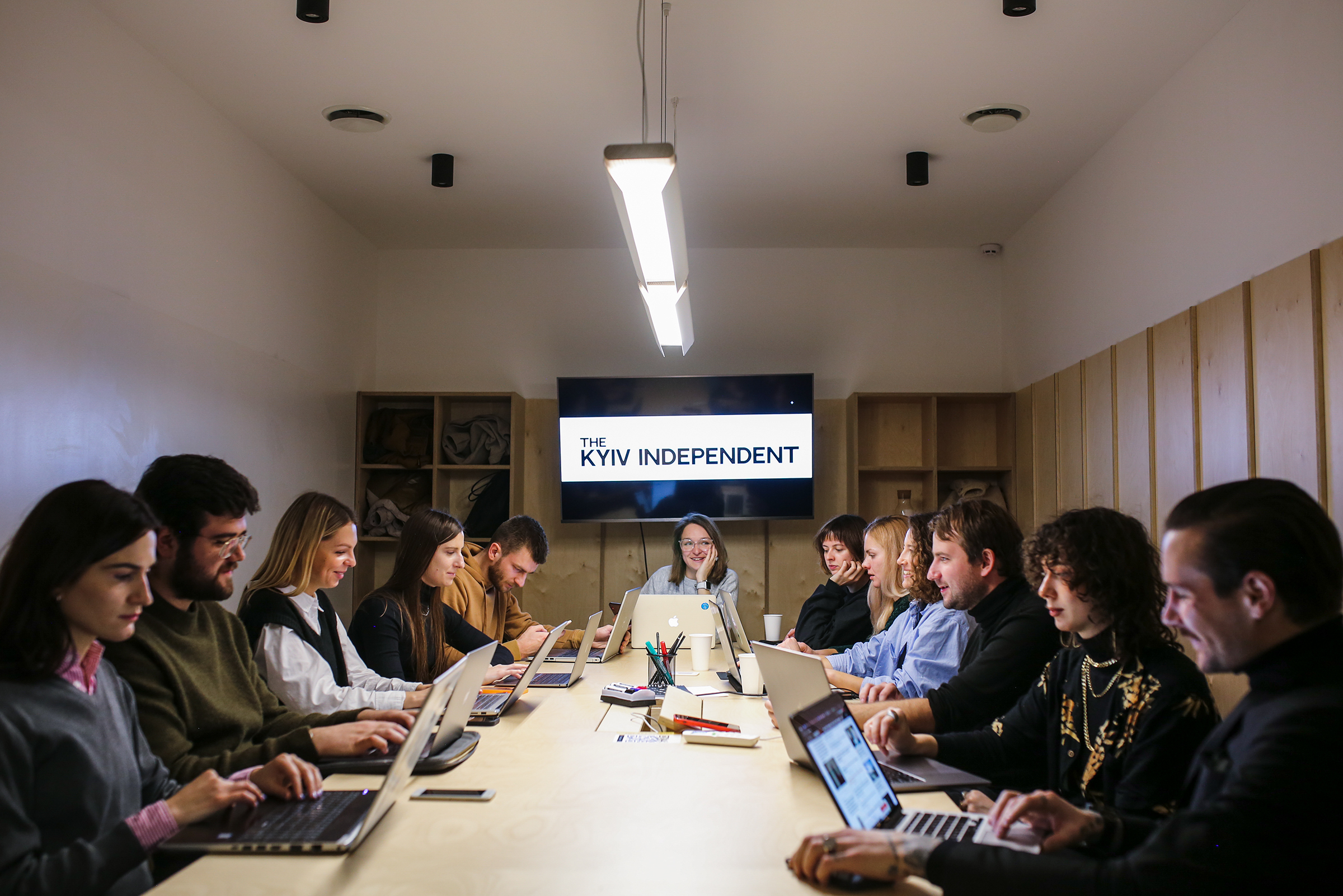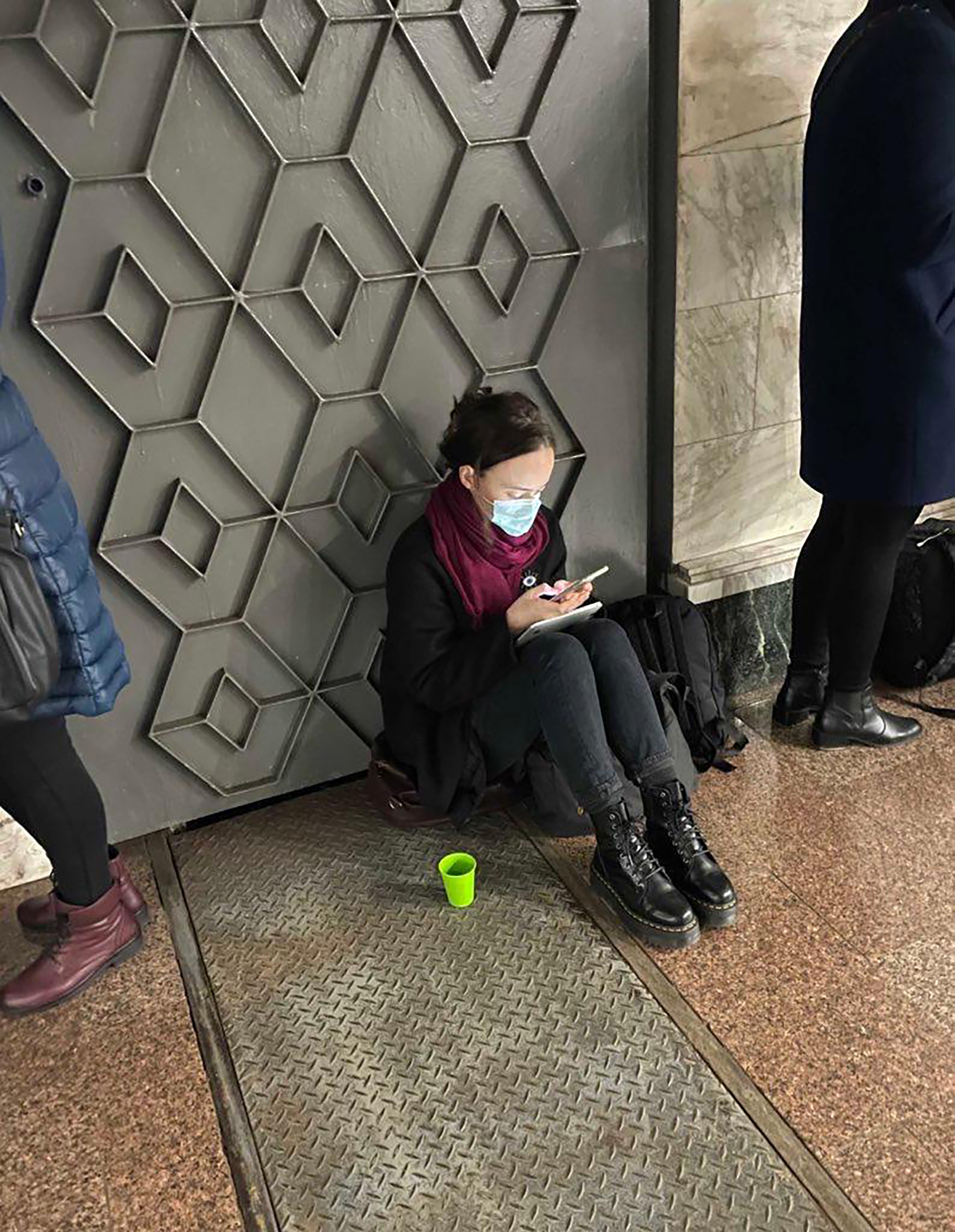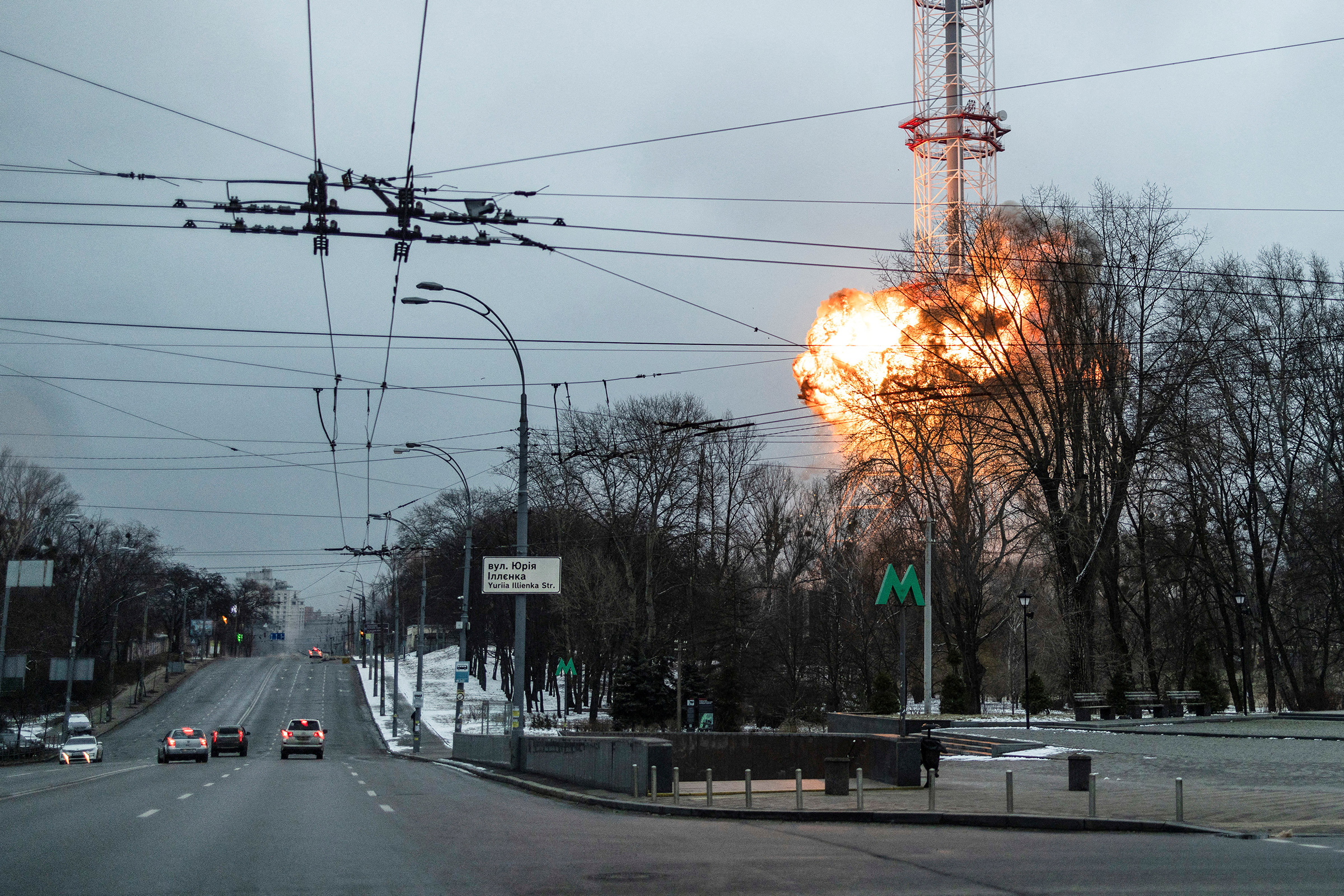
The morning that the shelling started in Kyiv, Olga Rudenko faced an excruciating decision. As the editor in chief of The Kyiv Independent, she knew that most of the staff were on their way out of the capital or were already abroad. But she had not yet made plans for herself, in part because she thought she had more time. “My plan was to stay in Kyiv as long as it wasn’t directly threatened or attacked, which we kind of assumed would not happen immediately,” she says. “But as soon as Putin finished his TV speech, we started hearing explosions over Kyiv.”
Even then, she was hesitant to leave, and actually went into the office on Feb. 24 before realizing, after about half an hour alone there, that it wasn’t safe. When she was offered a train ticket to western Ukraine, she reluctantly accepted it, acknowledging it was the smart decision. But that hasn’t removed the guilt. “Even though rationally I understand that it makes more sense for me to be where I am,” the 32-year-old Rudenko says, “ I’m also feeling like Kyiv is my city and my home and I should be going through this with the rest of the people who stay there.”
Read More: How Putin Is Losing at His Own Disinformation Game in Ukraine
The difficulty of balancing safety with the demands of the job is one that all war correspondents face, but for Ukrainian journalists—many of whom never intended to cover conflict but have found they have no choice—it is complicated by the fact that what they are reporting on is a violent assault on their own country. That simple fact adds a level of emotional distress and uncertainty to the many professional dilemmas they are confronting. It also makes the journalism they are producing all the more remarkable. “I think it’s fair to say that it is more difficult for us than, say, for foreign journalists,” says Rudenko. “We’re not just telling the story, we’re living the story.”

Simply doing the job exposes journalists to grave danger. Cameraman Yehvenii Sakun was killed in a March 1 missile attack on a Kyiv television tower. Some reporters have fled to other countries out of safety concerns or because they fear reprisals for their work should they be captured by the Russians. Those who stayed have found it difficult to secure body armor; at the war’s outbreak, there simply wasn’t any available to journalists, according to Jakub Parusinski, a media consultant and acting chief financial officer for The Kyiv Independent. Fear that their newsrooms will be targeted has some outlets broadcasting from secret bunkers.
On March 4, Russia intensified its long-tightening restrictions on independent media at home by passing a law that penalizes journalists who spread “fake news” about the military and the Ukraine invasion (including by calling it an invasion or a war) with up to 15 years in prison. In Ukraine, the Putin regime has been even clearer that it is targeting journalism. On Friday, a crew from Sky News was evacuated from the country after their car was intentionally attacked—and two journalists shot— by a suspected Russian “death squad.” In addition to the Kyiv tower attack, the Russian military has attacked two others elsewhere in the country, and seized one in the now fallen city of Kherson, reportedly using it to broadcast Russian TV. In Kherson, according to Veronika Melkozerova, executive editor of the independent New Voice of Ukraine, “they are preparing numerous false flag and propaganda operations.” On Thursday, her outlet was subject to a DDoS attack from hackers that took down its website for six hours; a second today disabled it for another six.
Read More: Putin Can Attack Ukraine But He Can’t Take Away My Home
The dangers of reporting in areas under active assault, coupled with widespread misinformation and active propaganda intended to obfuscate reality and affect morale, has complicated the task of verifying information. To reassure its readers, the newspaper Ukrainska Pravda, has taken to adding a line beneath its headlines that identifies the source of all of its news. Most times, that source–as it is for many local reporters—was found through Telegram, which has become the preferred communication medium of government officials and other authorities.
But even those can be unreliable, says New Voice’s Melkozerova. “Ukrainian government officials are constantly updating what’s happening on Telegram and Facebook. However we still have to be very careful when we’re searching for information on their channels because the Russians are creating fake profiles for officials.”

It’s because of those complications that Rudenko says she reminds her reporters daily to keep trying to get to the original source of anything they see on Telegram, and to keep verifying.“It’s basic journalism,” she explains. “But it’s very easy, when emotions are flying high, to forget that.”
The Kyiv Independent was founded in November by 30 journalists who had worked for the 26-year-old, English-language Kyiv Post, before being abruptly fired en masse from it after disputes with its new oligarch owner. The Kyiv Independent has experienced tremendous growth in readership since the start of the war. “On Twitter last Monday we had I think 30,000 followers and today we have 1,600,000,” Rudenko says. “So we’re capturing the world’s attention and establishing ourselves as the source of news from Ukraine on the ground.”
Read More: Meet the Lithuanian ‘Elves’ Fighting Russian Disinformation
Even so, they inevitably get things wrong. “We make mistakes almost every day. Apart from our regular stories, we’re doing a digest where we prioritize speed,” Rudenko says. All “that means we do make mistakes, and every day we have to make clarifications and corrections.” Based on information the mayor of Kherson had published on Telegram early on Thursday, for example, The Kyiv Independent published a news item saying that the city had been occupied by Russian forces. That was not yet the case—Kherson at that time was still just surrounded by Russian troops and the mayor had agreed to certain conditions—and the outlet issued a correction. (Kherson would fall later in the day.)
Given the stakes, some Ukrainian media outlets and individual journalists have openly embraced activism. The independent outlet Zaborona, which already had a reputation for it, maintains a blacklist of international companies that are still doing business in Russia and has published articles explaining how to make Molotov cocktails. Since launching in 2018, Zaborona has published in Ukrainian, English and Russian—but it ceased the latter soon after the invasion. “We have decided,” its editors wrote, ”that we can no longer and do not want to translate our materials into the language of a country that is killing civilians and our soldiers.”
Read More: The World Is Watching Russia Invade Ukraine. But Russian Media Is Telling a Different Story
Activist or not, all kinds of journalists are finding it impossible to separate themselves from the story. “The person who did a story about Ukrainian refugees crossing the border into Poland for us is a refugee herself right now,” says Rudenko. “We have an editor who is putting up news about one northern city being shelled, and her whole family is in that city. It’s all very personal.”

Adding to the pressure is the constant doubt over whether staying in targeted areas or leaving is the better decision. Melkozerova is currently working from her grandmother’s apartment in Kyiv, where she translates stories from Ukrainian journalists and publishes her own daily chronicle of events in the country. She had to leave her own place a few days ago when Russia began targeting the thermal plants in the residential area where she lived. Now, she sleeps on the floor beneath windows that have been taped to prevent flying glass in the event of a missile attack. “From my window, I can see the evacuation trains constantly going back and forth, taking people to safety,” she says. “But I know I can’t go because of my elderly relatives. I don’t know how to leave them here.”
Read More: They Called Ukraine Home. But They Faced Violence and Racism When They Tried to Flee
Fear for her young daughter’s safety led journalist Olga Tokariuk, who contributes to the EFE news service and other outlets, to reach the opposite conclusion; she left Kyiv with her small family several days before the invasion. “When I had to make this decision,” Tokariuk says, “I understood that the safety of my child prevailed over my professional duty.”
She is still uneasy about her decision, especially when she compares it with what she describes as the “incredible courage” of colleagues who have chosen to stay. She is now based in Western Ukraine, where, although an air raid siren forced her to postpone her interview for this story as she scrambled to a bomb shelter, she says she is currently safe. Initially, she worried that leaving the capital would mean she would have to give up her work. But she has found a way to do some reporting from her new location—covering the atmosphere inside a bomb shelter, for example, or visiting a volunteer center collecting donations of food, equipment and clothing. And as a freelancer who speaks several languages, she has found herself much in demand for interviews with other media. “I’m just trying to defend Ukraine in my own way,” Tokariuk says, “by talking to the world and spreading information about what is happening here.”
That same sense of purpose motivates Melkozerova. “If I didn’t do this work, I would constantly feel guilty,” she says. “Because I still have this idea—and maybe it’s very naive—but I’m still trying to show the world that Ukraine cannot be used as a shield against the Kremlin.”
To help both his own and other Ukrainian journalists continue to do their work, Parusinski, Kyiv Independent’s chief financial officer, has set up two GoFundMe campaigns. The first, established before the invasion, was originally intended to launch The Kyiv Independent, but has since been partly adapted to get its reporters the kind of equipment—body armor and satellite phones rank high—they need in wartime.
The second fund is devoted to supporting other independent Ukrainian outlets. “Our thinking was that it’s entirely unpredictable how things will go but it was clear overall that the media will need huge support,” he says. “Their market is gone, their government may be gone, their civilization is gone.”
Support for both funds has been strong: having far surpassed its original goal, the one for The Kyiv Independent has almost met its new one of 1.2 million pounds ($1.59 million). The other, to be used by vetted media, is doing almost as well. The top priority for the money, Parusinski says, is to develop the kind of technology solutions that will keep those media viable even if they’re attacked: cloud storage, server migration, hosting, debugging. “But we’re also trying to be a stopgap for expenses, logistical support, emergency supplies—getting all of them to the media before the cities are cut off.”
Should it become necessary, some of the money will also be used to set up local journalists in neighboring capitals like Warsaw and Vilnius so they can continue to cover the situation in Ukraine from a safe distance. Already, the Kyiv Independent has contingency plans in place should they lose access to the internet or find it impossible to publish for other reasons. “We have people across the border who have access to the website and know that if something happens, and we get cut off, they need to pick up the website,” says Rudenko. “We have people in North America who have all the passwords and they know what to do too.”
Rudenko has been buoyed by the support generated in the crowdfunding campaigns. But for all the pressure, and stress, and yes, guilt that she works under, she is also grateful simply to be able to do her job. “We are lucky to be doing something where we feel like we’re helping the Ukrainian cause, like we are fighting on our own front. We’re lucky to have this profession where we can make a difference and do the right thing. As much as it’s taken a toll on us, we’re also lucky at this time to be journalists.”
Correction, March 1
The original version of this story misstated Olga Rudenko’s age; she is 32, not 26.
More Must-Reads from TIME
- Donald Trump Is TIME's 2024 Person of the Year
- TIME’s Top 10 Photos of 2024
- Why Gen Z Is Drinking Less
- The Best Movies About Cooking
- Why Is Anxiety Worse at Night?
- A Head-to-Toe Guide to Treating Dry Skin
- Why Street Cats Are Taking Over Urban Neighborhoods
- Column: Jimmy Carter’s Global Legacy Was Moral Clarity
Contact us at letters@time.com